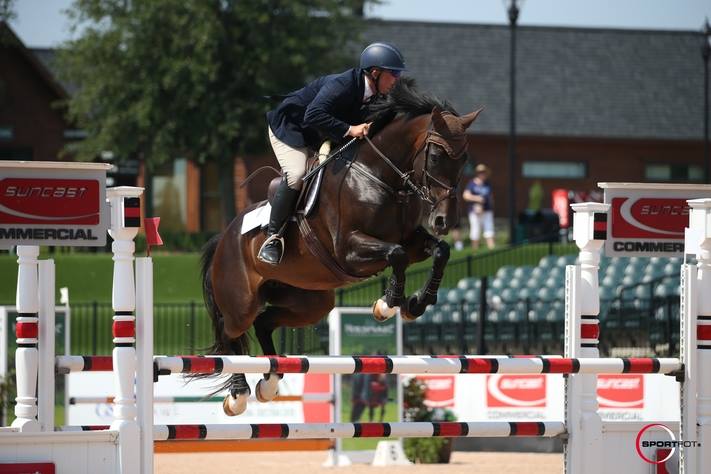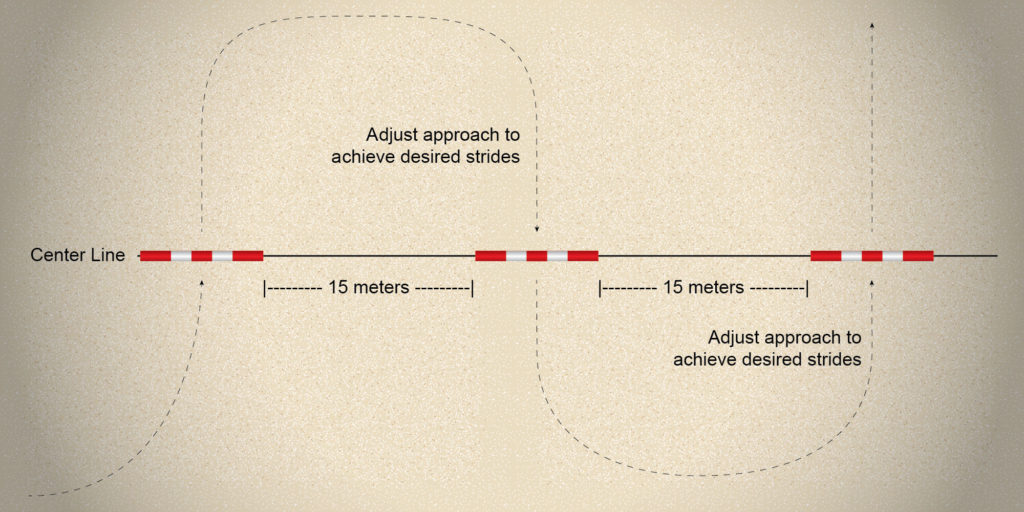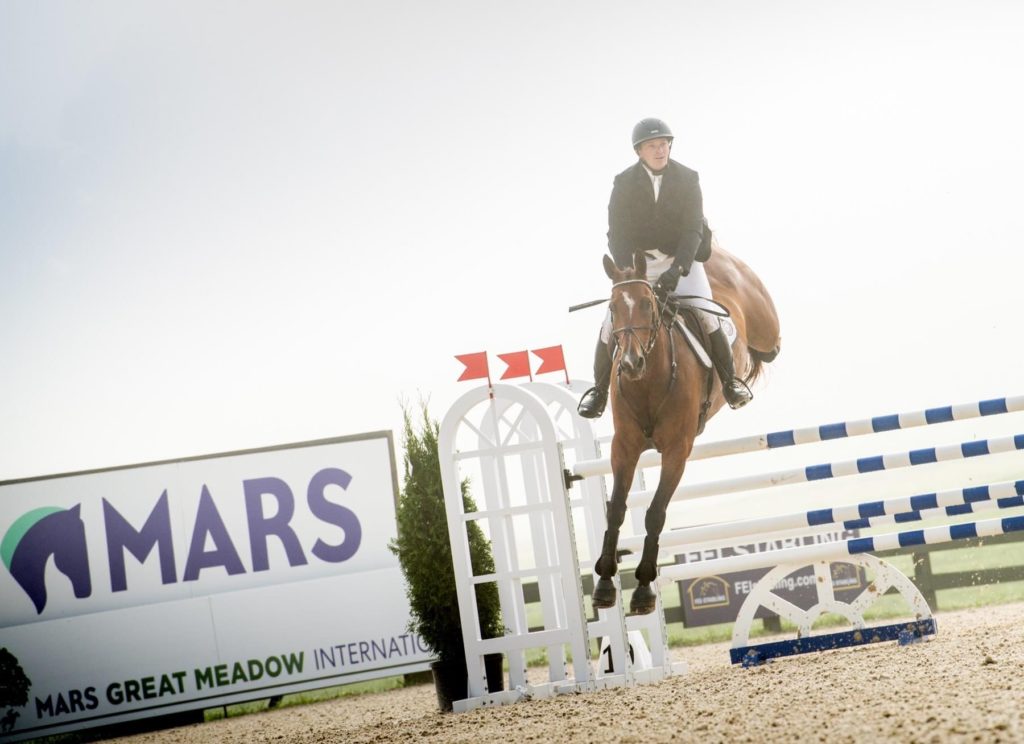Did you miss us? Jumper Nation Clinic is back! We’ve teamed up with top, respected riders who we love for both their horsemanship and their creativity with exercises they use at home and shows. Want to learn to maintain rhythm and balance through tricky distances? Try John Michael Durr’s simple exercise and feel your horse’s rhythm and balance glide through any distance. Words and exercise by John Michael Durr.
 John Michael Durr competing at the Tryon International Equestrian Center. Photo by Sportfot.
John Michael Durr competing at the Tryon International Equestrian Center. Photo by Sportfot.
I use this exercise frequently at clinics because it helps riders think about changing their lines and striding to adapt to a distance, rather than altering rhythm, balance, or tempo to “make” that distance. I like it because it helps riders feel the track. It can help any horse or rider improve their overall adjustability, and it works nicely as a warm-up exercise because you can start with three poles on the ground and then raise them incrementally as you and your horse become more comfortable with it.
 This exercise is suitable for all levels of riders and is designed to help them feel the track and think about changing their lines without interrupting the rhythm, balance, and tempo. Diagram/exercise courtesy John Michael Durr.
This exercise is suitable for all levels of riders and is designed to help them feel the track and think about changing their lines without interrupting the rhythm, balance, and tempo. Diagram/exercise courtesy John Michael Durr.
Start with three poles or vertical jumps set equal distance from each other, placed parallel to the ring’s centerline (see diagram). The key is to keep the distance between all three jumps equal. Fifteen meters is a good starting point. The idea is to choose your striding combination before you complete the track, and then adjust your turn and approach on a serpentine line to each fence so you hit that striding for each. For instance, start with seven strides and seven strides. Then try five strides to seven strides. Then, seven strides to five strides. If you’re doing this exercise at home without a coach, ask someone to watch you. Tell them what striding combination you intend to do to each fence, and that should keep you honest as you go.
If you’re starting with poles on the ground, I like to raise the middle jump first, and then elevate the other two as you go. Another nice thing about this exercise is that you can safely graduate to a height that provides consequence but not punishment. What I mean by that is, it can be big enough that you’ll feel when you’ve gotten it wrong, but not so big that you punish your horse when you make mistakes.
You can also adjust the exercise for the horse and the environment. If you ride a pony in a smaller ring, use smaller distances between the fences. If you’re jumping, say, a rangy Thoroughbred in a big open field, you’ll likely need wider turns and can set the fences further apart from one another, as long as the distances between them stays equal. For riders who struggle to hit the correct striding, soccer cones can help create turning lanes.
 This exercise can help riders learn to keep their eyes on the next jump, as John Michael demonstrates here. Photo by Shannon Brinkman Photography.
This exercise can help riders learn to keep their eyes on the next jump, as John Michael demonstrates here. Photo by Shannon Brinkman Photography.
I also like this exercise because it helps riders keep their eyes on the next jump, instead of the one they’re jumping. It’s also worth noting that this exercise goes easier if your horse can land on his correct lead. So, think about positioning your leg like a canter depart while you’re in the air. When you create that leg displacement over the fence, your horse will know which lead to pick up upon landing.
Try figure-eighting through this exercise in both directions until it feels like second nature. Once you and your horse learn to predict your striding and adjust your approach to get that striding in both directions, I think you’ll find it much easier to nail your approach to any tricky distances at a jumping competition while maintaining that all-important rhythm and balance.
About John Michael Durr
John Michael Durr draws from deep and diverse experience to craft tailored tools for horses and riders of all levels. Through clinics, lessons, tune-ups, and virtual consultations, he teaches riders practical and personalized skills that open a path for clear communication and mutual respect with their equine partners.
Throughout a decade of top results competing at the highest levels of three-day eventing, show jumping, dressage, and show hunters, he’s distilled the best advice from top mentors such as Lilo Fore, Capt. Mark Phillips, and Yves Sauvignon. When he achieved his Level-4 ICP certification in 2014, he was the youngest to do so at the time. As an FEI Eventing Level-2 Course Designer, he’s earned an exclusive perspective that has helped horses and riders safely and successfully navigate the questions at every level of competition.
The community at Durr Eventing and Show Jumping welcomes all horses and riders into its supportive environment, where they’ll be met with genuine comradery and taught the personalized, fundamental skills necessary to reach any goal.
This story was edited by Josh Walker/Athletux. To learn more about this equestrian marketing firm, visit www.Athletux.com or follow along on social media via Facebook or Instagram.
Grids and Exercises
- Sloane Coles & Spring Ledge
- Jane Ehrhart & River Hill Farm
- Emily Beshear & Deep Purple Eventing
- Doug Payne & DP Equestrian
- Max Amaya & Stonehenge Stables
- Geoff Teall & Montoga/Geoff Teall Virtual Training
- Katie Leverick & Millennium Farm
- Phillip Dutton & Phillip Dutton Eventing
- Caitlyn Shiels & True North Stables
Go Jumping!
